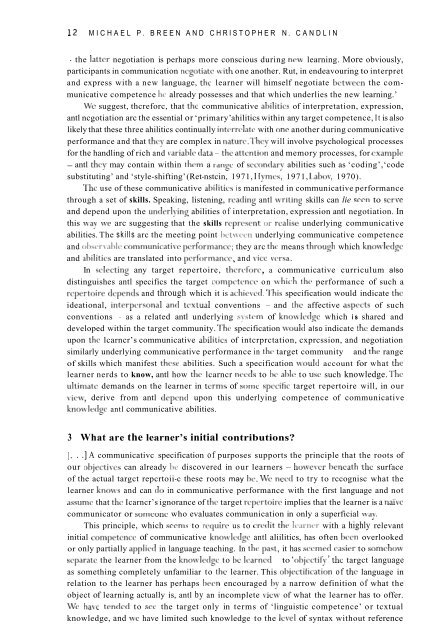Download - Search
Download - Search
Download - Search
You also want an ePaper? Increase the reach of your titles
YUMPU automatically turns print PDFs into web optimized ePapers that Google loves.
as12 MICHAEL P. BREEN AND CHRISTOPHER N. CANDLIN- the latter negotiation is perhaps more conscious during new learning. More obviously,participants in communication negotiatc hvith one another. Rut, in endeavouring to interpretand express with a new language, thc learner will himself negotiate lictwecn the communicativecompetence he already possesses and that which underlies the new learning.’Wc suggest, thcreforc, that the communicative ahilitics of interpretation, expression,antl ncgotiation arc the essential or ‘primary’ ahilitics within any target competence, It is alsolikely that these three ahilitics continually interrclatc with one another during communicativeperformance and that they are complex in naturc.l’hey will involve psychological processesfor the handling of rich and variablc (lata ~~ thc attcmtion and memory processes, for cxample- antl they may contain within them a rangc of sccontlary abilities such as ‘coding’,‘codesubstituting’ and ‘style-shifting’(Ret-nstcin, 1971, I Iymes, 1971, LAov, 1970).The use of these communicative abilitics is manifested in communicative performancethrough a set of skills. Speaking, listening, reading antl lvriting skills can lie sccn to scrveand depend upon the untlerlying abilities of interpretation, expression antl negotiation. Inthis \vay \ve arc suggesting that the skills i-cprcscnt or realise underlying communicativeabilities. The skills arc the meeting point lict\vccn underlying communicative competenceand ot)serval)le communicati1.e pcrformancc; they arc the means through which knodedgcand ahilitics are translated into pcrfoi-mancc, and vice vcrsa.In sclecting any target repertoire, thcrefoi-c, a communicative curriculum alsodistinguishes antl specifics the target compctcncc on \vhich the performance of such arcpertoire depends and through which it is achic\.ctl. This specification would indicate theideational, interpersonal and tcxtual conventions ~ and the affective aspccts of suchconventions ~ a related antl underlying tcm of knoLvlcdgc which is shared anddeveloped within the target community. The specification ~vould also indicate the demandsupon the lcarncr’s communicative aliilitics of intcrprctation, cxprcssion, and negotiationsimilarly underlying communicative performance in the target community and the rangeof skills which manifest these abilities. Such a specification \zould account for what thclearner nerds to know, antl how thc lcarncr needs to bc alilc to use such knowledge. Thcultimatc demands on the learner in terms of some specific target repertoire will, in ourvie\v, derive from antl depend upon this underlying competence of communicativekno\vledgc antl communicative abilities.3 What are the learner’s initial contributions?[. . .] A communicativc specification of purposes supports the principle that the roots ofour ohjecti\-cs can already be discovered in our learners ~ however liencath the surfaceof the actual targct repcrtoii-c these roots may lie. We need to try to rccognisc what thelearner knoivs and can do in communicative performance with the first language and notassumc that thc Icarncr’s ignorance of the target rcpcrtoii-c implies that the learner is a naivecommunicator or someone who evaluates communication in only a superficial \lay.This principle, which scems to rcquirc us to credit thc kat-ner with a highly relevantinitial competcncc, of communicative kno\vletlgc antl aliilitics, has often been overlookedor only partially applied in language teaching. In the past, it has seemed easier to somchon.separate the learner from the knonletlgc to I x lcarnctl to ‘oljcctily’ thc targct languageas something completely unfamiliar to the learner. This olijrctification of the language inrelation to the learner has perhaps been encouraged hy a narrow definition of what theobject of learning actually is, antl by an incomplete view of what the learner has to offer.Wc have tended to see the target only in terms of ‘linguistic competence’ or tcxtualknowledge, and we have limited such knowledge to the level of syntax without reference


